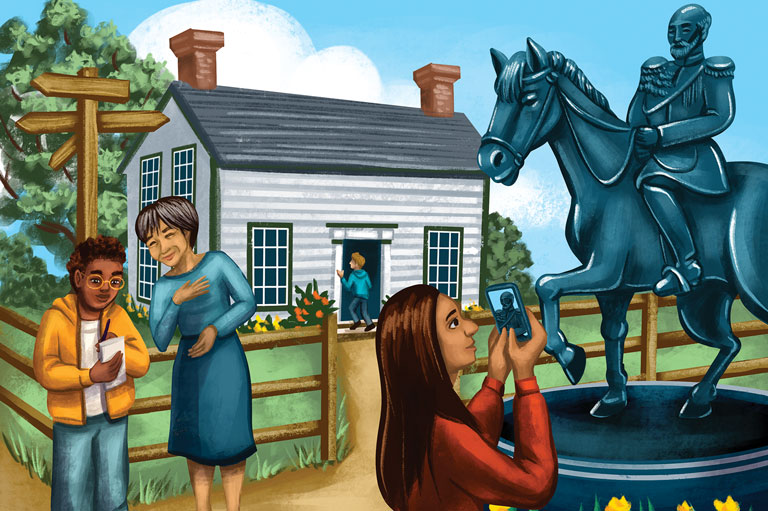Explore the Role of Black People in the Fur Trade Industry
Grade Levels: 4/5, 6/7
Subject Area: Social Studies/History/Language Arts
This lesson plan is inspired by the article “Black Voyageurs” in the Black history in Canada issue of Kayak: Canada’s History Magazine for Kids (expanded in 2022) and the How Furs Built Canada issue of Kayak: Canada’s History Magazine for Kids.
Lesson Overview
These lessons will provide students with the opportunity to explore and investigate interactions among European, Black and Indigenous peoples, with a focus on delving deeper into the often untold experience of Black fur traders.
Time Required
- Inquiring Minds Explore the Role of Black people in the Fur Trade Industry
- 120 minutes – 3 blocks
- Exploration Continued
- 80 minutes – 2 blocks
Historical Thinking Concept(s)
- Establish historical significance
- Identify continuity and change
- Take historical perspectives
Learning Outcomes
Students will:
- Explore and explain their findings as well as understanding of the role of Black people in the fur trade industry
- Design and create job advertisements that will help demonstrate and reflect their understanding of the role of a fur trader
Background Information
These lessons are intended to help support the exploration of the untold history of the role that Black people had in the fur trade industry when working for companies such as the Hudson’s Bay Company or the North West Company during the 1700s and 1800s.
The Lesson Activity
Activating: How will students be prepared for learning?
Using a K-W-L chart, the teacher will work to activate students’ prior knowledge and understanding of the fur trade in Canada, before exploring and extending student knowledge.
Use a K-W-L chart; what I think I know, what I want to know and what I learned to record student thoughts before delving deeper into the topic of the role of Black people within the fur trade.
Padlet is a great resource that can be used to record student thoughts and knowledge of the fur trade. You can create a free account through https://padlet.com. If you select the gallery button on the Padlet page you can find a K-W-L chart that you can use with your students or you can create your own page. Alternatively, you could also draw a K-W-L chart on the board or on chart paper.
Discussion Questions:
- What do you think you know about the fur trade? Get students to share what they know and have learned about the fur trade from books, videos or previous learning experiences.
Use the images from the “Black Voyageurs” story in Kayak and/or these linked images.
Option 1: Using Technology
Copy and paste the images onto Padlet or project them onto a screen. Use the discussion questions below to give students the opportunity to think about the images that have been displayed.
Option 2: Four Corners & Milling to Music
If you do not have access to a projector you can also print the images and place them around the classroom and have a milling to music opportunity for students. Milling to music can be set up by first selecting a song, playing the song for a short time and then stopping the music at different intervals throughout the song in order to give students the opportunity to share answers to the discussion questions. When the music stops, students will go to the closest image and share their reflections and observations with others in the classroom.
Discussion Questions:
- What do you notice/observe from these images?
- Why do you think I have shown you these images?
- How do you think these individuals may be connected to our understanding of the fur trade?
- Share with students that although the role that Black people had in the fur trade is often untold, Black people, in particular Black men, were a part of the fur trade that took place in what we now identify as Canada and the United States during the 1700s and 1800s.
Guiding Questions:
- What type of jobs do you think Black people had in the fur trade?
- What skills do you think they brought to the industry/their jobs?
These questions will support student thinking and their reflections on the role of Black people in the fur trading industry. These questions will also support the first learning activity.
After explaining this part to students, you may wish to ask students to share any questions that they might have about Black people in the fur trade. You can add these questions to your Padlet and re-visit them throughout the exploration. Alternatively, the K-W-L chart could also be posted within the classroom and used as a reference throughout students’ exploration.
Acquiring: What strategies facilitate learning for groups and individuals?
Students will work in groups of three to read and explore information from a non-fiction text that will help support them when working to create a job advertisement.
Reading non-fiction texts:
Explain what a non-fiction text is and the purpose of subtitles or headings within a non-fiction text. Tell students that they will be using parts of an online article to help them to look at the qualities or skills fur trade companies such as the Hudson’s Bay Company and the North West Company were looking for when they hired individuals to work for them.
Tell students that although each subheading may not outright tell them what skills the company is looking for in an employee, they will be able to use the information from the text, as well as their prior knowledge to help them make inferences about the skills fur trade companies wanted.
Using the story “Black Voyageurs” from Kayak assign one or two paragraphs to a group of students and have them work together to create a list of skills that fur trade companies were looking for. Use the graphic organizer in the resources section to help students organize their information. The Google Read&Write extension or application can be used to help support students who may need it, as this application allows students to listen to the text as it is read to them.
Come together as a class and take up student responses. Use the evidence that students have gathered from the text to make connections as to why the skills that they identified were important for those that worked for the Hudson’s Bay Company and the North West Company.
While the answers may vary, some student responses may include the following:
- Dedicated worker
- Hard worker
- Flexible
- Able to adapt to different weather conditions
- Ability to read a map, good navigation skills, good understanding of directions
- Multilingual, can speak more than one language when communicating with different groups of people
- Physically fit
- Able to get along with others
- Good paddler
- Strong
If students forget to add some of these skills, encourage students to use their knowledge of what a fur trader does to help them add skills to their graphic organizer:
Optional prompting questions that can help expand student responses:
- What does a fur trader do?
- What skills do you think a fur trader would need to have or develop in order to be successful at their job?
Job Specific Skills:
- Effective hunter: able to hunt and capture different animals
- Skillfully set traps that will prevent animals from escaping
- Knowledge of and skill in using a variety of different weapons when hunting such as a bow and arrow
- Creativity when making different weapons for hunting
- Can skin animals for their fur
- Knows how to prepare pelts for different uses
Get students to think about job specific skills as well broader skills that can be found in the article.
Applying: How will students demonstrate their understanding?
Present the following to your students: The first assignment along your journey is to create a job advertisement. Using the information from your investigations, you will create a job post to advertise an opening with either the Hudson’s Bay Company or the North West Company. Remember, you want to persuade others to apply to this job! This means you need to make your job posting sound as appealing as possible while still including at least three different skills that individuals must have when applying to this job.
Note to teacher: you can use current-day job ads as a way to explore some of the ways in which companies advertise their jobs. Some questions to help when exploring current-day advertisements may include: how does the company use persuasive language? How can you use this information to bring persuasive language to your writing?
Materials/Resources
- Option One: chart paper, markers, music
- Technology Option: computer projection screen, access to the internet to access the following link: https://padlet.com
- Graphic Organizer Template
Images: Pierre, Georges (George) and his brother Étienne (Stephen) Bonga
Themes associated with this article
Advertisement




